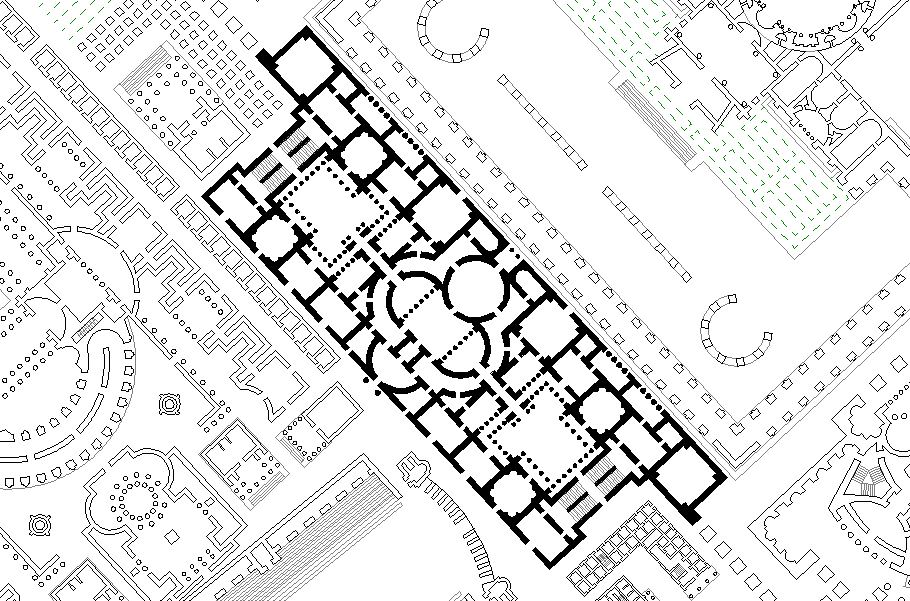The first of the thermae, or great public baths of Rome, were the thermae Agrippae, built by Agrippa in 27 B.C., at the same time with the Pantheon; but as the aqua Virgo which supplied these baths with water was not completed until 19 B.C., the baths themselves can hardly have been opened before that date. Agrippa called these thermae by the name Laconicum (sc. balineum), and adorned the structure with many works of art. They were burned in 80 A.D., and restored either by Titus or Domitian, and afterward by Hadrian between 115 and 125. A later restoration was carried out by Constans and Constantius in 344-345 A.D.
The excavations of recent years and the drawings and notes of architects of the sixteenth century, when much of the building was still standing, furnish us with considerable information. The original thermae of Agrippa occupied a rectangular space 86 meters wide and 228 meters in a north-south direction, from the present Pantheon to that part of the ruins which is called the arco di ciambella. These thermae were not connected with Hadrian's Pantheon, and therefore probably not with the original Pantheon of Agrippa. Hadrian enlarged the area of the baths toward the east and west, and appears to have rebuilt them almost entirely. About the time of Severus they were enlarged still more, so as to cover an area 260 meters long and 200 wide, extending as far south as the modern Corso Vittorio Emanuele. Countless architectural and decorative remains have been found in this area, but all that is now visible of any importance is the hall directly south of the Pantheon, and the arco di Ciambella. The hall is rectangular, 45 meters long and 19 wide, and represents in the main the frigidarium of the original baths of Agrippa. The apse 9 meters in diameter, in the north wall, and the large pedestal for a statue are additions of Hadrian. Along each of the longer sides stood four columns of pavonazetto and red granite. Between the first and second and the third and fourth columns on each side were three niches, two rectangular and one semicircular. Round the hall ran a remarkably well executed frieze. Fragments of this and also of the marbles with which the hall was lined are still in situ. Opposite the apse was the passage into the tepidarium. The hall was paved with slabs of marble, especially pavonazetto and nero Africano. The walls are only 1.75 meters in thickness, and hence it is probable that the hall of Agrippa had only a wooden roof or none at all. The cross-walls which have been found between the drum of the Pantheon and the north wall of this hall date from Hadrian's time, and as they are not connected with either structure, but simply abut against them, it is clear that they were intended to serve as buttresses, so that a heavy roof might be put over the hall.
Arco di Ciambella is the name given to the portion now standing of a large domed roof which may be seen above the houses in the street of the same name. The hall, of the roof of which this dome is a part, was about 25 meters in diameter, and belonged to the latest enlargement of the thermae, being very probably a caldarium.
Adjoining the thermae, Agrippa constructed a stagnum, or artificial pool, of considerable size, which probably extended from the thermae as far as the modern church of S. Andrea della Valle. This stagnum was bordered by the horti Agrippae, gardens in which were many treasures of art. An open channel, called the Euripus, flowed through the gardens to the Tiber and doubtless served as an outlet for the stagnum. Horti and stagnum played an important part in the entertainments of Nero, and although some remains have been found which probably belong to this group, nothing more definite is known of their location or extent. (Platner)
| |
Vincenzo Fasolo, "The Campo Marzio of G. B. Piranesi".
2691d
1956
Tafuri text
1996.09.02
Palus Caprae 283b
| |
|
